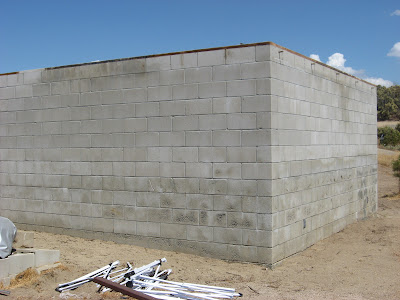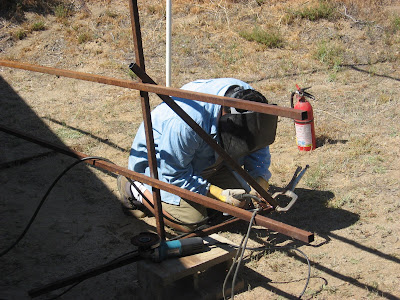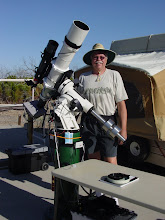The weather finally eased up at Anza this weekend. This time it was almost 20 degrees cooler than last week, being only in the mid-80s but the humidity was still in single digits. There was a chance of thunderstorms and I kept my eye on a line of cumulus building throughout the day 20 miles east of me in the Coachella Valley where Palm Springs is. There was a nice cool outflow blowing from them all day. I started sanding and painting the nine, 18 foot long, 1X1s by about 9 AM and surprisingly completely finished them by 12:30 PM.
I had two curious visitors stop by to see how we're doing, both of them club members out for the weekend. Jim Hannum (whom I met for the first time today) owns the home at the top of the hill with two other club members. Their joint observatory is larger than their house. It houses four large telescopes and they are building another telescope that has a mirror diameter of 36 inches. He offered us some help in that they have a 14 foot open trailer that we can now use anytime to truck stuff to the Anza dump. We are starting to generate a considerable construction debris pile that we will have to truck out in the next few weeks.
Rick Wiggins stopped by a bit later. He has a completely remote controlled observatory on site. I found out he has quite a background in remote control. His current Anza observatory is the third one of his own that he has built. He has also helped Russ Croman and others build some of the remote control telescope businesses in New Mexico, including around Cloudcroft. Just in general conversation today, he has already saved us from making some errors. We were going to control the scopes with Bluetooth from our control desks so we wouldn't need to lay any wire - he said forget Bluetooth - there's too much interference and its too unstable for our purposes. He can show us how to run just one line from each scope to the control desk - that will be for all telescope functions as well as the webcams to observe the equipment. He suggested re-considering the warm room set-ups. Rick said that he is always using white light in his warm room - never red light! If that's the case, John doesn't need a separate warm room in the observing area but can use the main warm room. Rick suggested using what would have been Phil's room as a common bunk room.
John and I will have to consider these things. Fortunately, we have some time for that because the roof comes first. Rick said he would be happy to provide whatever expertise and time we need from him to get our place up and running remotely - wow! He's so generous because he says that he very much likes to help amateurs who are serious about the hobby.
I haven't said much to this point about exactly what I'm going to do with this observatory when its done. I have been interested in astronomy since I was a kid. Other than a short period in the '70s when I did visual observing with a 6 inch reflector, I was basically an arm chair astronomer until '95 when I joined the New Jersey Astronomical Association, of which I am still a long distance member. After moving to Southern California I became interested in astro photography, mainly because I started to wear bifocals and it became very hard for me to look through an eyepiece with my glasses on so I thought that imaging would be a good substitute. By 2004 I was imaging with a DSLR and a small 4 inch refract or on a mount that followed the sky. I frequently came out to this Anza club site for overnight trips on the weekend to do imaging. Its a great spot being far from city lights, at over 4600feet altitude, and very still skies. However, the downside is that the days can be extremely hot in summer, there can be snow in winter, and lots of varmints: scorpions, rattlers, coyotes, and rare mountain lions. Its pretty scary when you are out there alone at night looking at your computer screen and you can hear things moving out beyond your field of vision.
I have also become interested in what is called photometry. That's the measurement of slight changes in the amount of light that an object gives off. Some stars change brightness, asteroid rotation rates can be measured, other stars can explode, yet other stars are multiple and information can be learned by measuring their changing brightness. There is a lot of possibilities for real scientific research with amateur equipment. I'll write more about this anotehr time.
 Second coat looks good. The ceiling panels that need replacing can also be seen.
Second coat looks good. The ceiling panels that need replacing can also be seen.  Looking toward the front door and the electrical panel.
Looking toward the front door and the electrical panel. Instead of four very steep temporary stairs, we will build a permanent steel stair way. The first step will actually be a landing at the observatory door. That will allow us to build three steps instead of four in the same space. The treads will be a nice 11 inches wide instead of the 5 inches shown here.
Instead of four very steep temporary stairs, we will build a permanent steel stair way. The first step will actually be a landing at the observatory door. That will allow us to build three steps instead of four in the same space. The treads will be a nice 11 inches wide instead of the 5 inches shown here. More steel will need to be purchased but this was a great start and an unexpected cost saving.
More steel will need to be purchased but this was a great start and an unexpected cost saving. 

 The blue ridge in the distance is Palomar Mountain, about 12 miles away. Just beyond and below the ridge line is Palomar Observatory.
The blue ridge in the distance is Palomar Mountain, about 12 miles away. Just beyond and below the ridge line is Palomar Observatory.
 Two views of the partially painted warm room
Two views of the partially painted warm room The steel dome rail system can be seen on top of the cinder block wall when we took possession in June
The steel dome rail system can be seen on top of the cinder block wall when we took possession in June Only a 2X6 cap piece of wood is left of the original rail system.
Only a 2X6 cap piece of wood is left of the original rail system.
 Outside walls after power washing. Lower block surface erosion extends to floor level of observing room and will be repaired
Outside walls after power washing. Lower block surface erosion extends to floor level of observing room and will be repaired John and I pointing that we moved the rails from the top of the wall to the pile on the ground
John and I pointing that we moved the rails from the top of the wall to the pile on the ground
 Tony giving John CPR while he's pinned also
Tony giving John CPR while he's pinned also Summing up, we had a slow start to the day with the shortage on the hose, but we not only achieved the day’s plan of power washing the warm room, but we also washed the whole outside and took down the steel rail ring. Not bad for a day’s work.
Summing up, we had a slow start to the day with the shortage on the hose, but we not only achieved the day’s plan of power washing the warm room, but we also washed the whole outside and took down the steel rail ring. Not bad for a day’s work.
 Diligently sanding somewhere beyond 110 degrees
Diligently sanding somewhere beyond 110 degrees

 Here are some of the 2X6s and 2X8s staged for sanding and sealing:
Here are some of the 2X6s and 2X8s staged for sanding and sealing: And the 2X4s:
And the 2X4s: 
 We found a small electrical panel inside that had two 15 amp breakers. Power is delivered throughout the site by underground conduits. Our feed was part of a grid laid out over twenty years ago by club members. The main problem is that we have no grid map and all of the original people have moved on. We did know our power originated in a 200 amp main breaker panel about 500 feet away at the club’s observatory and there were several junction boxes along the way. Thirty amps should be enough for our needs with off peak usage but our main concern is how near capacity is that 200 amp box on star party nights. So far there have been no power problems but theoretically the panel must be near capacity when we have our star parties. We have as many as 30 people drawing power from that feed during star parties.
We found a small electrical panel inside that had two 15 amp breakers. Power is delivered throughout the site by underground conduits. Our feed was part of a grid laid out over twenty years ago by club members. The main problem is that we have no grid map and all of the original people have moved on. We did know our power originated in a 200 amp main breaker panel about 500 feet away at the club’s observatory and there were several junction boxes along the way. Thirty amps should be enough for our needs with off peak usage but our main concern is how near capacity is that 200 amp box on star party nights. So far there have been no power problems but theoretically the panel must be near capacity when we have our star parties. We have as many as 30 people drawing power from that feed during star parties. That will be replaced with steel steps and redesigned to give a wider tread. The observing area is in good shape despite open to the sky. There is a single permanent pier in the center of the area that we will remove and I will use as my pier. Two permanent piers will be installed. There is also enough space for John to build a small warm room for his use. There is some construction on top of the cinder block wall that will have to be removed so we c an install our roll off roof track. What is there now is the support structure for the dome that was originally planned. They completed it as far as having an 18 foot diameter track installed.
That will be replaced with steel steps and redesigned to give a wider tread. The observing area is in good shape despite open to the sky. There is a single permanent pier in the center of the area that we will remove and I will use as my pier. Two permanent piers will be installed. There is also enough space for John to build a small warm room for his use. There is some construction on top of the cinder block wall that will have to be removed so we c an install our roll off roof track. What is there now is the support structure for the dome that was originally planned. They completed it as far as having an 18 foot diameter track installed. Summing up the first day, we really had no bad surprises. The very good thing was being pleasantly surprised with all that steel being in such usable condition.
Summing up the first day, we really had no bad surprises. The very good thing was being pleasantly surprised with all that steel being in such usable condition. 

 The current structure is divided into two sections: a currently roofed over warm room and the telescope room. The warm room is where we control the telescopes from. We're changing it slightly by dividing the warm room into two smaller rooms. One room will be a common room that will be my control area and also have a flat panel TV and a snack table: microwave, coffee maker, etc. The other room will be my sleeping area. Our telescope room is so large, roughly 18 feet on a side, that John will actually build his control/sleeping area there and there will still be room enough for three telescopes.
The current structure is divided into two sections: a currently roofed over warm room and the telescope room. The warm room is where we control the telescopes from. We're changing it slightly by dividing the warm room into two smaller rooms. One room will be a common room that will be my control area and also have a flat panel TV and a snack table: microwave, coffee maker, etc. The other room will be my sleeping area. Our telescope room is so large, roughly 18 feet on a side, that John will actually build his control/sleeping area there and there will still be room enough for three telescopes.
 There will be nine mid-truss assemblies with the design shown below:
There will be nine mid-truss assemblies with the design shown below: The roof assembly will ride on ten wheels, each having a load bearing capacity of 2,500 pounds. The wheels will ride on rails on top of the east and west walls with the rails continuing beyond the north wall by five feet. The rail system for the west wall is shown below. The track rail rests on another beam that sits on top of the wall cap of three plates welded together - the wall top and two side plates welded together and then attached with bolts through the cinder block wall. This rail system is for the west wall - note the flat track rail.
The roof assembly will ride on ten wheels, each having a load bearing capacity of 2,500 pounds. The wheels will ride on rails on top of the east and west walls with the rails continuing beyond the north wall by five feet. The rail system for the west wall is shown below. The track rail rests on another beam that sits on top of the wall cap of three plates welded together - the wall top and two side plates welded together and then attached with bolts through the cinder block wall. This rail system is for the west wall - note the flat track rail. The east wall rail is shown below. Note that the track rail has an angle iron welded in the track to accommodate the V-wheel. The two rails are different because the east rail provides the tracking ability and the west rail has a wide, flat track wheel to allow the roof to expand or contract with temperature changes, preventing any binding, especially important with remote operation.
The east wall rail is shown below. Note that the track rail has an angle iron welded in the track to accommodate the V-wheel. The two rails are different because the east rail provides the tracking ability and the west rail has a wide, flat track wheel to allow the roof to expand or contract with temperature changes, preventing any binding, especially important with remote operation. As I said before these rails will extend over the warm room roof another five feet past the north end of the building. We will construct two posts in concrete bases to support that structure as below:
As I said before these rails will extend over the warm room roof another five feet past the north end of the building. We will construct two posts in concrete bases to support that structure as below:
 Currently the site comprises about 50 leased and free observatory pads, about 12 private observatories, an 8 bed, 2 kitchen, 2 bath bunkhouse, and a club observatory housing the Kuhn telescope, and a 22 inch Schmidt-Cassegrain that was instrumental in making a number of supernovae discoveries. Other observing areas include the “RV Area” and “Last Members In” area.
Currently the site comprises about 50 leased and free observatory pads, about 12 private observatories, an 8 bed, 2 kitchen, 2 bath bunkhouse, and a club observatory housing the Kuhn telescope, and a 22 inch Schmidt-Cassegrain that was instrumental in making a number of supernovae discoveries. Other observing areas include the “RV Area” and “Last Members In” area.  However, an unexpected second choice appeared in mid-May when a partially built observatory became available. It’s the small building that seems to have a circle over part of it in the aerial photo below.
However, an unexpected second choice appeared in mid-May when a partially built observatory became available. It’s the small building that seems to have a circle over part of it in the aerial photo below. 
